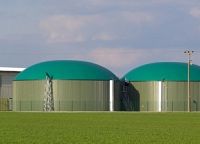

A small town in Gloucestershire is set to lead the way in the use of sustainable technology after a biogas power station was built which produces energy derived from agricultural and animal waste.
The cupcake-shaped biogas plant, located on a farm south of Cirencester, is powered by chicken litter and pig manure, as well as corn, wheat and grass from local farms.
The plant produces a methane-rich biogas via a process of anaerobic digestion, which is then used to power a combined heat and power unit generating around 1 megawatt of electricity, enough to supply 350 homes. This provides residents of Cirencester with a low cost alternative to oil, coal and foreign gas and means they are not subjected to the smells normally generated by farms.
The wasted heat energy (around 2 MW) is then used for keeping the animal sheds warm, drying grain and local housing central heating and hot water. Every bit of energy, whether electrical or heat is used, unlike in traditional power stations where the heat is ejected to the atmosphere via vast cooling towers.
After the biogas is extracted, the fibrous material left is spread on the land as fertiliser. This is a major benefit to both farmers and the environment as fertiliser is normally very expensive and the process to produce fertiliser uses large amounts of fossil fuel and emits significant quantities of CO2.
The use of local resources is called distributed energy and has many positive effects, as explained by Peter Kindt, managing director of Alfagy, the company supplying the plant’s technology, "What makes this project exciting is that farmers deliver energy to the urban environment. We believe this is a model for the future of local power generation.”
For more information, see: